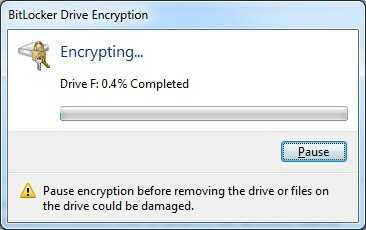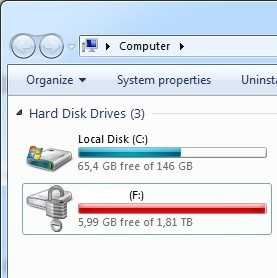Is the option "Encrypt used disk space only" available in Windows 7?
Unfortunately no. This option was introduced with Windows 8, as announced in the Microsoft TechNet Tip of the Day post BitLocker 'Encrypt Used Disk Space Only':
Previously, BitLocker encryption has been an ‘all or nothing’. Either a volume was completely encrypted or it was not. Windows 8 brings us a new option, ‘Encrypt Used Disk Space Only’.
Why does BitLocker take hours on a brand new empty disk?
Because without the Encrypt Used Space Only option, BitLocker must encrypt the entire disk, i.e. both data and free space (technically it only wipes the free space). This is also why the volume has only 6 GB free space during the encryption process. Here's the Microsoft BitLocker Team's explanation of what's going on:
Q: I enabled BitLocker on my volume and – poof! – all my free space is
gone! What’s wrong? More importantly, how do I get it back?
Good news: nothing is wrong and the only thing that you have to do to
get it back is wait. Here’s a high level explanation (some intricate
technical details have been omitted for brevity).
In the IT world “delete” usually means “remove from plain view” rather
than “obliterate out of existence”. Unallocated disk space is prone to
contain interesting data: rotting skeletons of compensation
spreadsheets, “deleted” text files with passwords and credit card
numbers, discarded autosave copies of top secret presentations. Hence,
BitLocker cannot just ignore free space when the volume is being
encrypted.
On the other hand, encrypting (or, to be exact, “reading, encrypting,
and writing back”) free space is a real waste on a typical volume that
is usually less than twenty percent full. As a performance
optimization, BitLocker simply overwrites unallocated space with
noise, thereby avoiding redundant reads. As expected, wiping free
space is about two times faster than encrypting data, but it still
takes considerable time on large volumes.
Now, free space tends to be very fluid. Unallocated chunks of disk
space appear and disappear all over the place, all the time.
Determining whether a given sector needs to be encrypted or wiped at a
particular moment of time is a considerable technical challenge.
BitLocker solves this problem by creating a huge file that takes most
of the available disk space (leaving 6 GB for short-term system needs)
and wiping disk sectors that belong to the file. Everything else
(including ~6 GB of free space not occupied by the wipe file) is
encrypted. When encryption of the volume is paused or completed, the
wipe file is deleted and the amount of available free space reverts to
normal.



@Kinnectus New vs old does not matter, of course. But here it's an empty disk, so there is no data to initially encrypt. Here in this topic it is said it should be instantly done...
– Basj – 2018-11-22T14:55:49.3871Make also sure you use the fastest USB port(s) available on your machine. While the answer addresses the need to encrypt the entire drive, 2TB can be done faster – usr-local-ΕΨΗΕΛΩΝ – 2018-11-23T08:47:25.063
1@Basj: Instantly enabling encryption ("encrypted drive") only works with Windows 8 and above. That's basically just telling the drive which is already encrypting anyway to secure the decryption master key or replace the decryption key password with a different one, whichever. Nothing really changes on the actual disk. Early Bitlocker implementations were unluckily pretty dumb to the point of being unusable. They don't get around encrypting every block in software when the hardware is already doing that anyway. – Damon – 2018-11-23T13:31:44.167
@Damon this isn't correct on drives that don't support hardware encryption (and I've not seen details on whether this is true for HW encrypted drives). Used space only encryption does exactly that: it reads, encrypts, and writes every block on the volume that's in use. See the quote from Microsoft in my answer for details. – I say Reinstate Monica – 2018-11-23T18:49:27.057